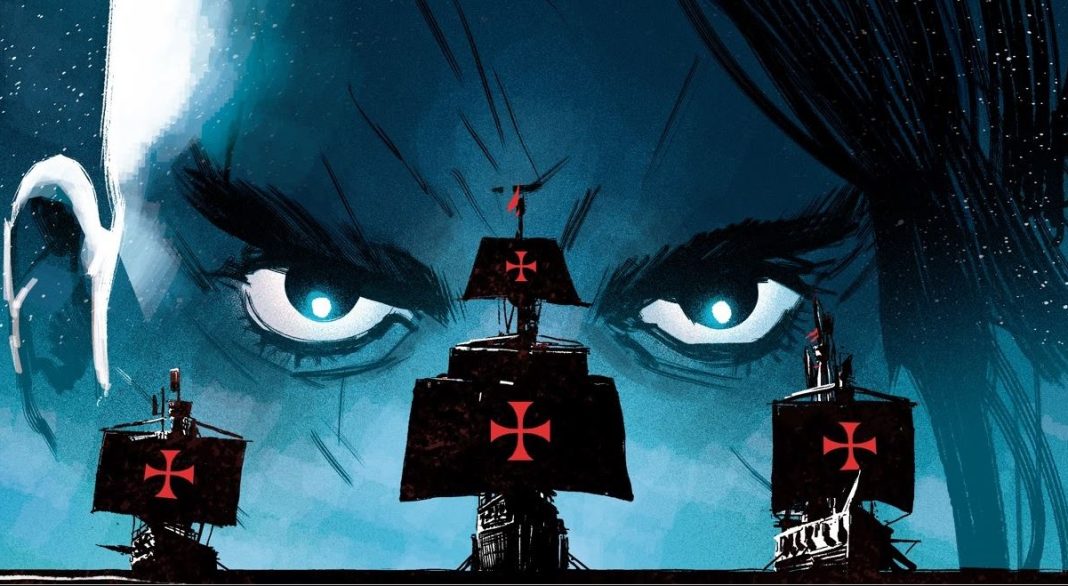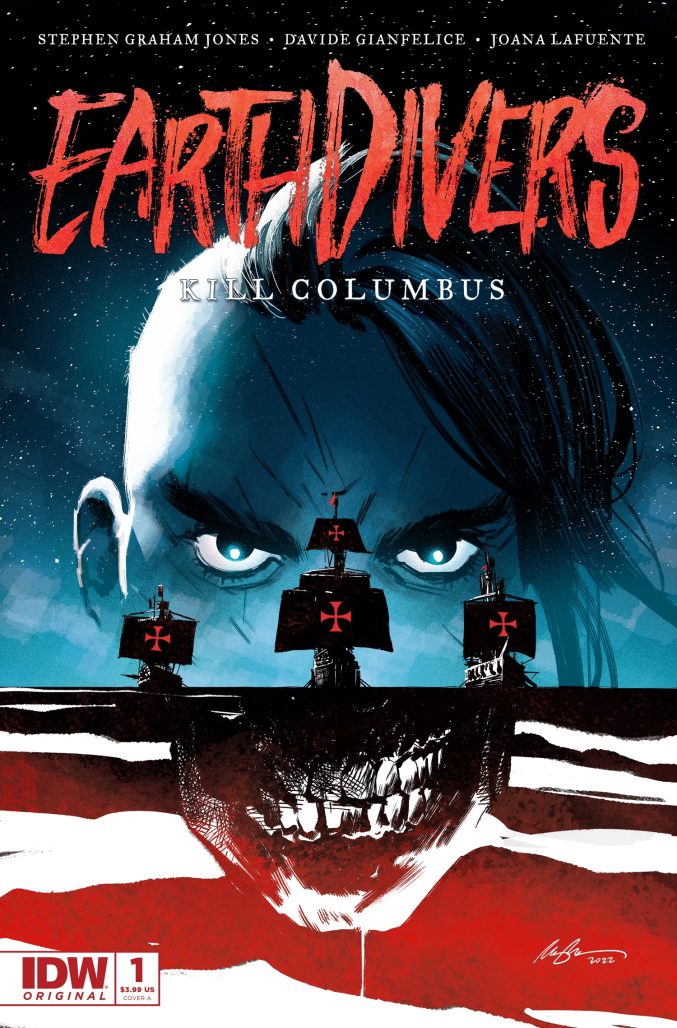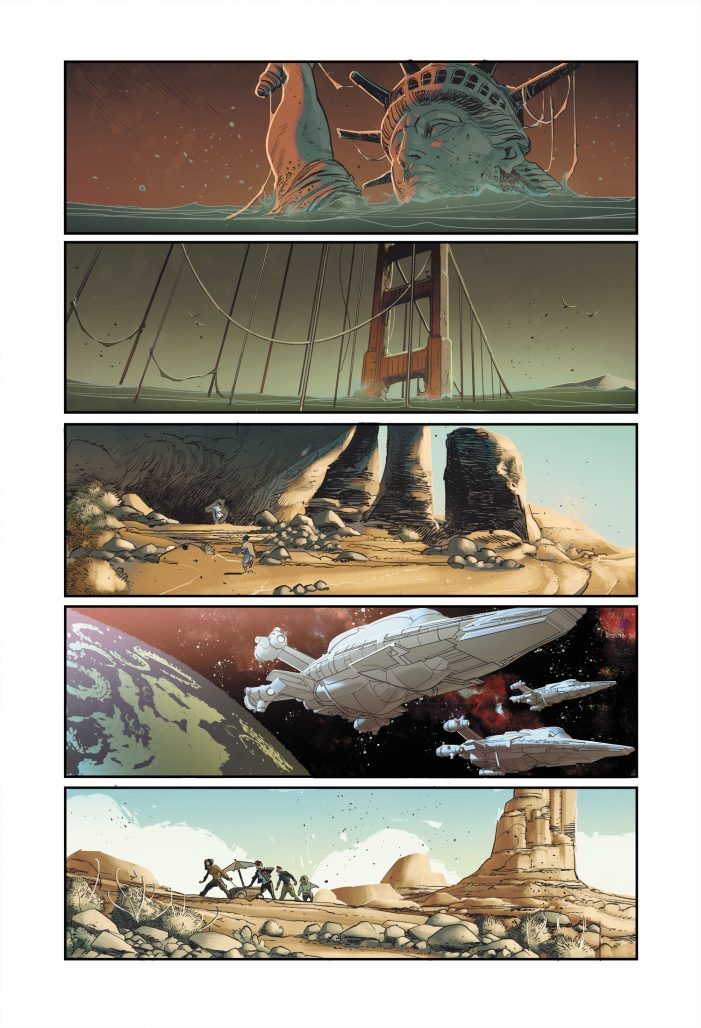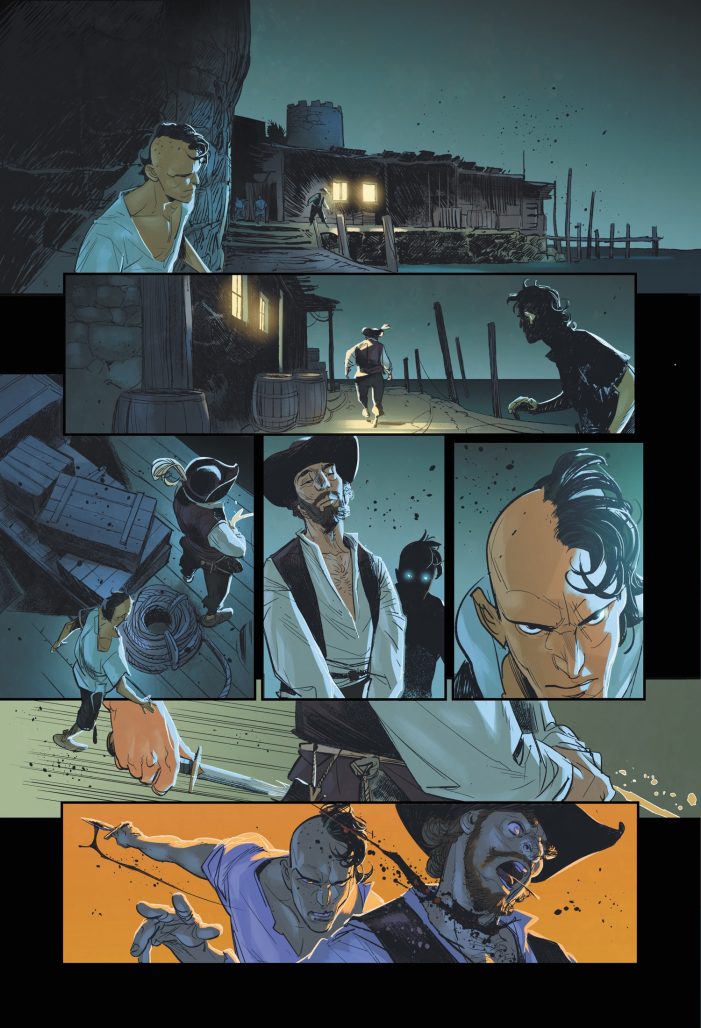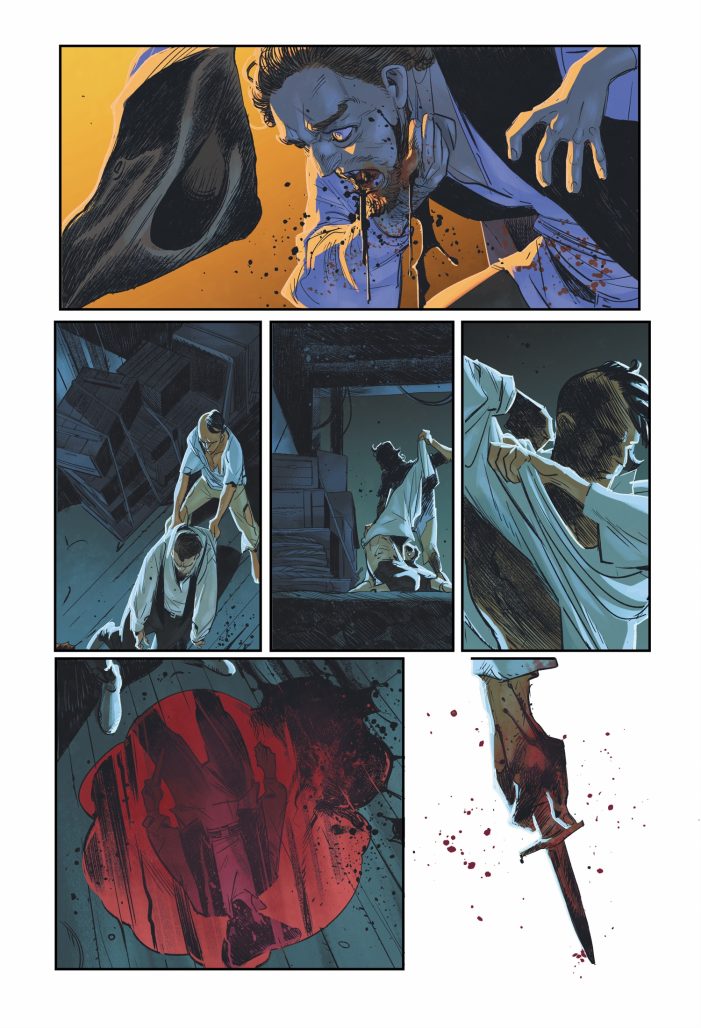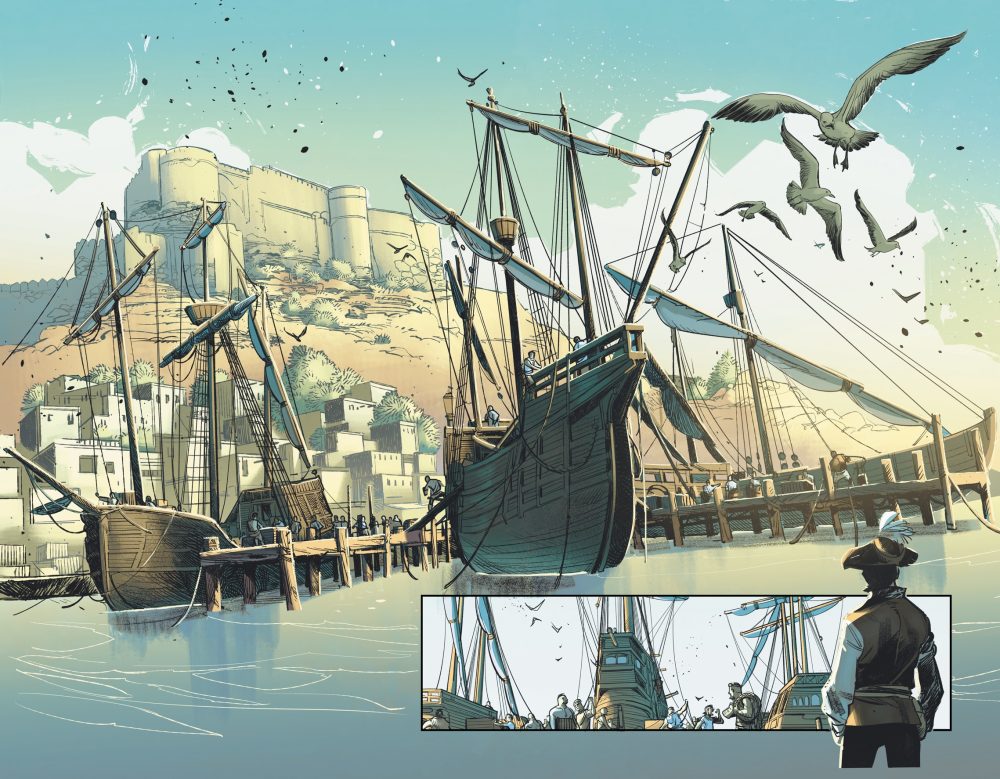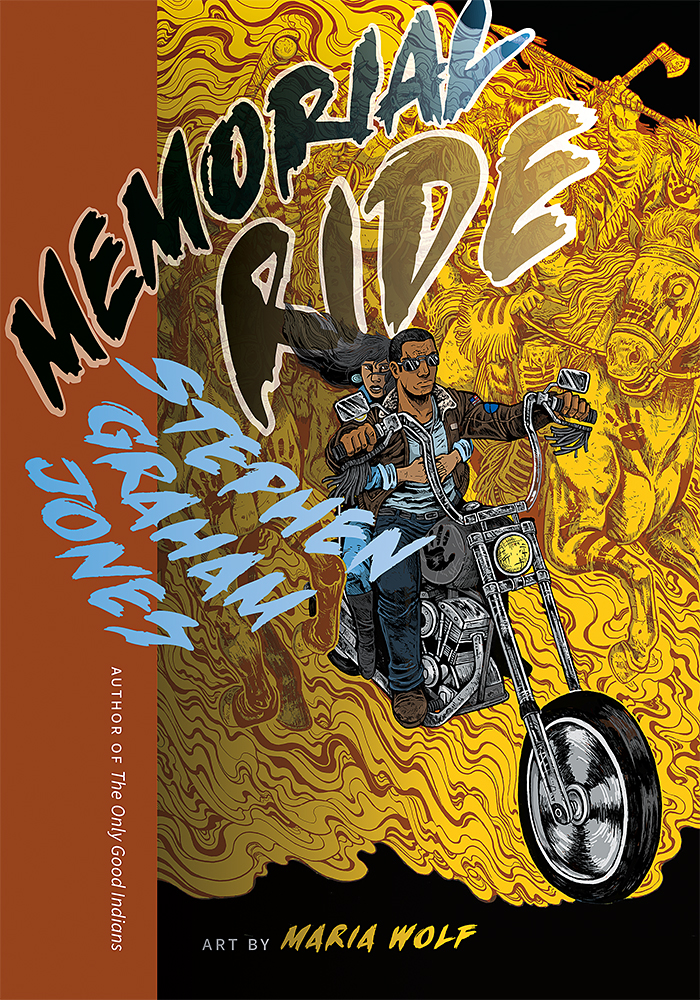Given the chance to go back in time to change world history, odds are killing Hitler is on top of most everyone’s lists. To erase the Holocaust, save the world from another total war, and to quite simply unburden global history from a considerable amount of evil is just too seductive a proposition to pass up. And yet, the head of the Nazi Party isn’t the only historical figure whose death could alter the entire trajectory of our world’s timeline, perhaps for the better.
For horror author Stephen Graham Jones, Christopher Columbus is just as deserving of consideration when the opportunity to knock off a figure who’s done considerable damage at global scale comes around. This is the premise behind Graham Jones (who is Blackfeet Native American) and artist Davide Gianfelice’s new IDW Originals series Earthdivers, set for release on October 5th, 2022.
The story follows four Indigenous survivors in a post-apocalyptic America that decide the world would have better odds of survival if America itself was never allowed to carve out its existence. Their solution? Go back in time and kill the man responsible for the creation of such a damning place: Christopher Columbus.
Earthdivers, which according to Graham Jones has already been acquired by 20th Century Television for small-screen development, mixes slasher elements into its time travel tale to explore how far violence can go in pressuring history to change its relentless course. In essence, murder becomes the focus of a debate on how much bad can one consider doing in the name of good. I mean, when has bloodshed ever not been a brutal substitute for difficult conversations in fiction? Graham Jones hopes to say quite a bit with his own brand of violence here, a title he’s earned thanks to his critically-acclaimed novels (My Heart is a Chainsaw and The Last Final Girl among them).

The Beat had the chance to talk history, the possibility of an Indigenous revenge slasher in Earthdivers, and how writing comics compares to prose writing with Stephen Graham Jones in anticipation of the new series’ October release.
RICARDO SERRANO: What made Earthdivers a story that deserved to be told as a comic book?
STEPHEN GRAHAM JONES: I think the reason I did this as comic book instead of doing it as prose fiction is that it didn’t make sense for it not to be a comic. In fact, pitching it as prose would’ve been an entirely different process, which is perhaps a bit more akin to selling it as a scripted show or movie. It’s already been sold to 20th Century Television, by the way, and it’ll be interesting to see how it transfers over into that medium.
Another reason is I’ve always been in love with comic books. If I had ended up creating comic books 25 years ago, I’m not sure I would’ve ever worked on prose fiction. I read a lot of novels coming up, but I read even more comic books. I feel like that’s the system I want to play back into.
SERRANO: The idea of going back in time to kill gargantuan historical figures with an extensive history of blood to their names does not come up as often as one thinks, at least in terms of who should get the time traveling assassination treatment. Inglorious Basterds comes to mind, with Tarantino pulling the trigger on Hitler (literarily). Could you comment on the challenges of telling a story that considers the changes that come with killing Columbus?
Graham Jones: I feel writers go for killing Hitler because he was, well, the worst. But going back to kill Christopher Columbus has not been done in a big way yet. I suspect it has something to do with who has the most anger at Columbus. Me being Blackfeet, along with Indians across North, Central, and South America, I think we all have a pretty legitimate beef with Christopher Columbus for opening open the door and filling in the land with infections, warfare and land-takers all over.
I think every culture has their own big villain, someone who added a lot of bad into their national story. There may be somebody in every country who has been considered kind of an embarrassment for the people. You know, when word started getting out about this story a lot of people reached out to me to say “I’ve had that idea my notebook for 12 years and I’m glad you’re doing it.” I don’t necessarily think the concept itself is new, but perhaps exploring the possibilities by focusing on another figure that isn’t Hitler can take it into new territory. I just happened to be the one jumping on it.
What interests me about these kinds of things, going back to get rid of some terrible person in history, are the ethical complications. That’s where you find a lot of story. If you go back in time to when an especially bad person was young and kill him before he gets to unleash all these horrible things upon the world, does that mean that becoming a child killer is the only option? Why should one group’s wants and needs be more important than the lives of other people? I don’t know if there’s a good answer to that question.
SERRANO: How much research went into Earthdivers? Did you see the comic as an opportunity to tear down myths or inform people on the lesser known aspects of the men that journeyed to what would later become America?
GRAHAM JONES: I did a lot of research for this book, more research than I’ve done for anything else, really. I had to go read a lot of books about Christopher Columbus, especially on his first voyage. What’s interesting is that there’s a lot of disagreement about his story. It’s a little bit confusing to a certain point. I mean, we don’t even know what language or languages he spoke. That detail gave me the idea to have the main character, Tad, speak a lot of languages so he could communicate in different scenarios.
That said, we’re not going into America with Columbus. I think we know the terrible, terrible things the people on these expeditions did with the Native populations they came into contact with. It would be fun to get into some of that and educate people and dispel with the illusion of the “Great Christopher Columbus,” but I think all that stuff is glanced at through the characters’ rage and in their desperate hope of righting the injustices that took place as a result of his travels.
I also want to deal with the forces at play when a group of people, regardless of their intention, set out to mess with the past in such a massive way. Does history supply another Christopher Columbus to keep history marching on as it’s supposed to? Has gravity locked around this timeline in a certain way or is it elastic enough to allow things to go a different way? And if not, how does it push back?
Stephen King‘s 11.22.63 novel, about a man that travels back in time to stop the Kennedy assassination works with that to great effect. I wanted to explore that as well.
SERRANO: Given your masterful takes on the slasher genre, I think one could argue there are elements of it in Earthdivers, albeit from the perspective of the “good guy.” Was this something you tried to bring to the story?
GRAHAM JONES: That’s a good way to put it. To me there’s two kinds of slashers: the revenge slasher, which makes up a large percentage of slashers, and the mad killer slasher that just shows up in town and starts killing people (think Slumber Party Massacre or Halloween). I don’t know that Earthdivers is either one of those. It’s hard to call it a revenge slasher when there’s so much distance put between the people involved, centuries of distance at that. Nevertheless, it feels like revenge for an American Indian to take on Columbus. This is for all the beans.
There’s some slasher in Earthdivers because it’s one of the muscles I know how to use well. There’s already a pretty gruesome kill in the first few pages and things will escalate and get pretty gory before all is said and done. I wouldn’t say it’s a pure slasher, though. I’d say it’s more slasher-influenced.
SERRANO: I guess you could say there’s the possibility a kind of ‘righteous slasher’ is brewing in the story, complicating the very act of killing despite how much someone might deserve to be at the end of the knife.
GRAHAM JONES: That’s something I’ve always wanted to correct with the slasher. Human life just doesn’t matter in them, especially when it comes to women. Women’s bodies are basically disposable in slashers and that shouldn’t be the case. I always prefer to make it matter when people die. While we can enjoy having that righteous feeling, I still prefer to add complications to the act and make people care for the person who’s being righteously murdered.
SERRANO: How has Davide Gianfelice’s art shaped your approach to the story behind Earthdivers? Have you gone back and tweaked certain sequences given the trajectories the art took throughout the ‘making of’ process?
GRAHAM JONES: Oh, it completely influenced my approach, even at the character sketch level. For instance, I had never once thought about what Tad might look like. Once I saw Davide’s choice of hair style, his expressions, just his overall look, it impacted the character’s direction. I was able to weaponize the designs Davide came up with and then come up with different ways to develop them just off what those characters looked like.
My favorite part was seeing how Davide could make panel after panel of dialogue just be so dynamic. I can have like one page of basically conversations going back and forth between two people and he would find a way to make it come alive. It’s so cool that he has that instinct, that ability, that experience.
But also, I love it when his art is expressive enough that I can go in and erase full word balloons or captions because the art captured something that I wanted to get across so well. I no longer had to use text to have a character express something like “I’m scared” or something. He has a really good sense of layout and a really good instinct for finding ways to keep those pages turning.
SERRANO: Earthdivers is certainly not your first comic book work as you’ve had a story featured in Marvel Voices: Indigenous Voices #1 and a graphic novel called Memorial Ride with Maria Wolf (a grindhouse-inspired Western of sorts that shatters Frontier tropes and furthers indigenous representation in comics). Do you see more comics work in the future?
GRAHAM JONES: Oh yes. It’s weird because comics take me longer to write than prose fiction. I’m not saying like a single issue takes me more than a novel. I mean going from page to page, word to word. I go slower with scripts because I have to actually outline, and I’ve never been a planner.
It’s making me become a different kind of writer, I think. It’s really fun and you do keep growing and developing your craft. This is my first time doing a monthly comic book, so I don’t want to get in over my head with projects, if that makes sense. Because then it makes me want to get in on another project. I know a lot of writers that juggle like three or five titles a month. That’s amazing to me, because even just this one title is taking up a lot.
I feel like what I’m doing right now is learning. When I wrote the script for Memorial Ride I went all in like Alan Moore. It was granular. I described every corner, every shadow. What I learned from doing that was that I don’t have to fill in every blank. I could script a bit more like Matt Fraction in his Hawkeye series, where he allowed David Ajá to open up the story and let it bloom across the page. His scripts are so scalable, so pared down that they allow for a lot of freedom. I think that when you partner with an artist, and then a letterer and a colorist, you can feel comfortable leaving things somewhat barebones as a kind of just gesture that invites people to crawl inside the story and make it come to amazing life.


